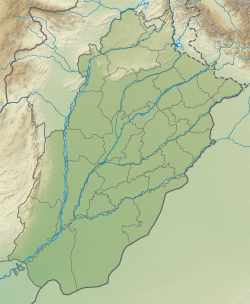
Back Harappa Afrikaans هارابا Arabic هارابا ARZ হৰপ্পা Assamese Харапа Byelorussian Харапа Bulgarian হরপ্পা Bengali/Bangla Harappa Catalan Хараппа CE Harappa Czech
 A view of Harappa's Granary and Great Hall | |
| Location | Sahiwal District, Punjab, Pakistan |
|---|---|
| Coordinates | 30°37′44″N 72°51′50″E / 30.62889°N 72.86389°E |
| Type | Settlement |
| Area | 150 ha (370 acres) |
| History | |
| Periods | Harappa 1 to Harappa 5 |
| Cultures | Indus Valley Civilisation |
| Site notes | |
| Condition | Ruined |
| Ownership | |
| Public access | Yes |
| Website | www |
Harappa is an archaeological site in Pakistan, about 25 km (16 mi) north of Sahiwal. The Bronze Age Harappan civilisation, now more often called the Indus Valley Civilisation, is named after the site, which takes its name from a modern village near the former course of the Ravi River, which now runs 8 km (5.0 mi) to the north. The core of the Harappan civilisation extended over a large area, from Gujarat in the south, across Sindh and Rajasthan and extending into Punjab and Haryana. Numerous sites have been found outside the core area, including some as far east as Uttar Pradesh and as far west as Sutkagen-dor on the Makran coast of Balochistan, not far from Iran.[1][2]
The site of the ancient city contains the ruins of a Bronze Age fortified city, which was part of the Harappan civilisation centred in Sindh and the Punjab, and then the Cemetery H culture.[3] The city is believed to have had as many as 23,500 residents and occupied about 150 hectares (370 acres) with clay brick houses at its greatest extent during the Mature Harappan phase (2600 BCE – 1900 BCE), which is considered large for its time.[4][5] Per archaeological convention of naming a previously unknown civilisation by its first excavated site, the Indus Valley Civilisation is also called the Harappan Civilisation.
The ancient city of Harappa was heavily damaged under British and French rule, when bricks from the ruins were used as track ballast in the construction of the Lahore–Multan Railway [citation needed]. The current village of Harappa is less than 1 km (0.62 mi) from the ancient site. Although modern Harappa has a legacy railway station from the British Raj period, it is a small crossroads town of 15,000 people today. In 2005, a controversial amusement park scheme at the site was abandoned when builders unearthed many archaeological artefacts during the early stages of building work.[6]
- ^ Giosan, L., Clift, P. D., Macklin, M. G., Fuller, D. Q., Constantinescu, S., Durcan, J. A., ... & Syvitski, J. P. (2012). Fluvial landscapes of the Harappan civilization. Proceedings of the National Academy of Sciences, 109(26), E1688-E1694.
- ^ Dales, George F. (June 1962). "Harappan Outposts on the Makran Coast". Antiquity. 36 (142): 86–92. doi:10.1017/s0003598x00029689. ISSN 0003-598X. S2CID 164175444.
- ^ Basham, A. L.; Dani, D. H. (Winter 1968–1969). "(Review of) A Short History of Pakistan: Book One: Pre-Muslim Period". Pacific Affairs. 41 (4): 641–643. doi:10.2307/2754608. JSTOR 2754608.
- ^ Fagan, Brian (2003). People of the earth: an introduction to world prehistory. Pearson. p. 414. ISBN 978-0-13-111316-9.
- ^ Cite error: The named reference
unescowas invoked but never defined (see the help page). - ^ Tahir, Zulqernain. 26 May 2005. Probe body on Harappa park, Dawn. Retrieved 13 January 2006. Archived 11 March 2007 at the Wayback Machine
© MMXXIII Rich X Search. We shall prevail. All rights reserved. Rich X Search


